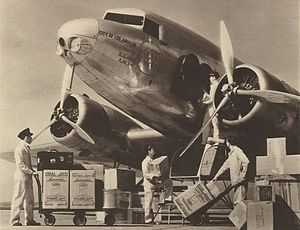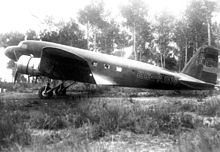Douglas DC-1
The Douglas DC-1 was the first airliner produced by the Douglas Aircraft Company from Santa Monica , California ( USA ). It was considered revolutionary in its time and became the progenitor of a long line of civil (and later also military) propeller-driven aircraft from the famous American manufacturer. It had its first flight on July 1, 1933 from Santa Monica Airfield .
This then very modern machine had space for 12 passengers and was built as a direct competitor to the Boeing 247 . Their designation DC is derived from " D ouglas C ommercial". Only a single copy of the DC-1 was built as a prototype for the TWA , which it also tested in regular service from September 1933. The availability of more powerful engines allowed the aircraft to be extended to 14 seats. This larger model then went into series production under the name Douglas DC-2 .
history
The construction of the DC-1 became possible because after the invention of the half-shell construction for the aircraft fuselage and the monoplane for the wing, the weight and air resistance could be significantly reduced. This was first shown in America at the end of the 1920s with the Lockheed Vega , whose designer John Northrop created the basis for aircraft technology in the 1930s in some areas. Technically, the DC-1 was very similar to the Boeing 247 - but it could not be ordered by other airlines because it was only available to United Air Lines through an exclusive contract . Therefore, in 1932 , Jack Frye of Trans World Airlines put out a tender for a three-engine aircraft with flight performance similar to that of the Boeing 247, whereupon Donald Douglas developed the prototype DC-1. Douglas was of the opinion that the required performance could also be achieved with two engines. After a successful test in which the prototype had to fly safely over the Rocky Mountains with only one engine running , a twin-engine aircraft was finally accepted, but the DC-1 was too weak and too small. With more powerful engines and a longer fuselage, the DC-2 went into series production from 1934 . However, like the DC-3 (from 1936), the basic construction of the DC-2 is essentially identical to the DC-1.
The only DC-1 ever built reached Spain in 1938 via detours and first flew for the airline LAPE (Líneas Aéreas Postales Españolas), then during the Spanish Civil War for the Republican Air Force. On October 4, 1940, the take-off in Malaga was aborted and the aircraft caught fire. Although none of the occupants was killed, the aircraft was written off. The pilot was Rodolfo Bay Wright, later founder of the Spantax . The wreck lay in Malaga airport for several years, later the plane was scrapped.
Individual evidence
- ↑ Jennifer M. Gradidge: The Douglas DC-1 / DC-2 / DC-3: The First Seventy Years, Volumes One and Two . Tonbridge, Kent, UK: Air-Britain (Historians) Ltd., 2006, ISBN 0-85130-332-3 , p. 9.
- ↑ From the film "The DC-3: The Plane That Changed The World," Manbeck Pictures Corporation
- ↑ Aircraft accident data and report in the Aviation Safety Network (English)

